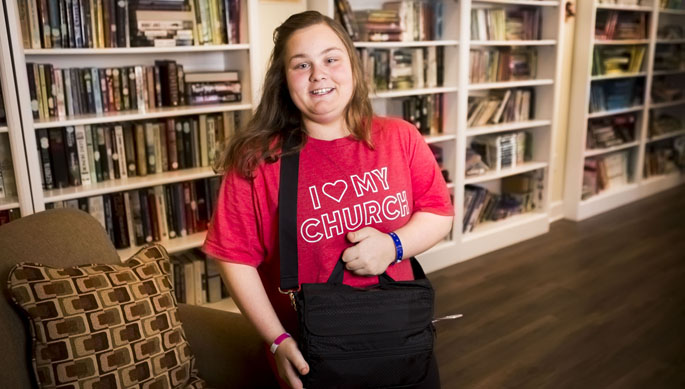
by Christina Echegaray
For nearly a month, 15-year-old Trinity Scott sported a black canvas messenger bag, the type any teenager might wear, filled with favorite books, lip gloss or school supplies. Her bag even had a name, “Alice.”
But far from any ordinary bag, what was inside was literally keeping her alive: a ventricular assistance device (VAD), an implantable medical device that helps circulate blood throughout the body and serves as a bridge to heart transplantation. The bag also meant she didn’t have to stay confined to a hospital room.
Trinity recently became the first pediatric heart patient at Monroe Carell Jr. Children’s Hospital at Vanderbilt to leave the hospital with a portable VAD while she waited for a heart transplant.
As she waited for her heart, she stayed in the Ronald McDonald House, three blocks from Children’s Hospital, which allowed her family to rest and feel like they were in “a home away from home.” The day before Thanksgiving, Trinity got her heart.
“The biggest reason to discharge the patient is to try to really normalize life while they are waiting for a heart transplant. In some ways, to be hospitalized can be a burden on the patient from both a mental and physical standpoint,” said David Bearl, MD, MA, Trinity’s pediatric cardiologist at Children’s Hospital and medical director of the Pediatric Ventricular Assist Device Program.
“From a rehab standpoint, we know the better the condition a patient is in going into a heart transplant, the better they rehab post-transplant, have a shorter intubation time and shorter ICU stay — all because they are healthier going into transplant.”
Trinity’s parents, Melanie and David White, were hesitant at first to leave the hospital while their daughter was on the VAD. Extensive conversations with the VAD team, Nancy Jaworski, APRN, VAD coordinator, and Bearl made the family more comfortable with the idea.
“We were worried if she had an arrythmia she couldn’t get out of, and if we would recognize something was wrong,” Melanie said.
“Nancy made us feel really comfortable. She taught us to change her dressing and gave us classes on the VAD and gave us tests. Being in the hospital gets exhausting. ‘Alice’ allowed us to get a reprieve.”
“They have bent over backwards for us, and they said if you need anything or have any questions, just call,” added David. “They made us feel at ease and educated us on what we needed to do.”
The VAD team had been waiting to find a family that would be a good fit to be discharged with the portable device, called HeartWare, which is virtually silent and undetectable unless the alarms sound to indicate there is an issue.
The White family could have gone home to East Tennessee but chose to stay close until they were confident with the device or until a new heart arrived. The heart came before the family ever had a chance to go back home.
Portable VADs have been available for adults at Vanderbilt University Medical Center for nearly two decades. The first non-portable LVAS (left ventricular assist system) was implanted in 1986 in an adult at VUMC, according Vanderbilt archives.
VAD technology is newer for the pediatric population. Children’s Hospital has used inpatient VADs for about 15 years. The VAD team is working to evaluate patients sooner, since evidence shows that VADs help improve the health of patients as a bridge to transplant. When the heart doesn’t have to work as hard, other body systems have time to recover.
In Trinity’s case, she had cardiomyopathy, a disease of the heart muscle that makes it harder for the heart to pump blood to the rest of the body. The Whites knew eventually she would need a transplant, but the decline in her heart function was sudden. Cardiomyopathy can be known as a “silent killer,” due to an increased risk of sudden cardiac death.
Months prior, Trinity had even been playing softball. Medication had helped sustain her heart, but then her heart began to fail. She was passing out at home and at school.
“We always knew she would need a transplant, but we didn’t think this fast. She just went downhill really fast,” Melanie said
The blood in her enlarged heart was also not flowing correctly, and the improper blood flow was putting increased pressure on her lungs. The pulmonary hypertension would make her ineligible for a heart transplant. Medication wasn’t helping. The cardiac team decided it was time to try a VAD.
“We knew she was probably a heart transplant candidate, but we needed to give her lungs a chance to recover. Her lungs responded exactly the way we thought they would (with the VAD),” Jaworski said.
As Trinity improved on the VAD, discussions began about letting her leave the hospital with the device. Jaworski helped the family get all the training they needed to understand the device, care for it and figure out what each alarm means. For families who do go back to their communities, Jaworski will also train the patient’s school nurse and work with the local pediatrician.
Bearl and Jaworski said they hope more families will be able to go home on a VAD, if the situation is right and a strong family support system is in place.
“This is a partnership, and we’ll have to spend time building trust with families, because this is not nothing,” Jaworski said.
“You really have to build a relationship with the patient and family so that they actually trust you enough to do what you’re recommending.”












